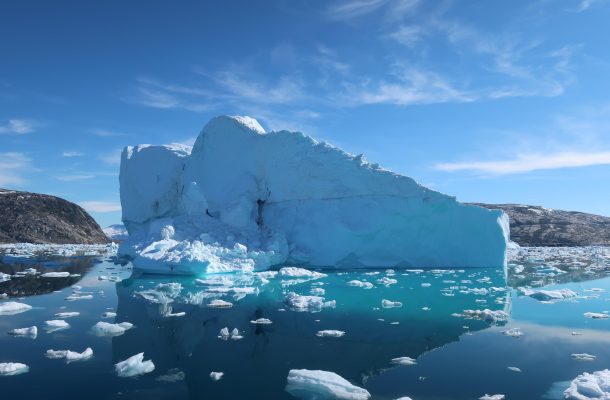Ice, ice baby

Limiting global warming to 1.5 °C could halve contributions from melting land ice to 21st-century sea-level rise, relative to projections based on current emission pledges by 2100, according to a paper published in Nature.
A second paper, also published in Nature, indicates that warming of 3 °C could cause sea level to increase by 0.5 cm every year by 2100 as a result of melting Antarctic land ice. The findings provide further insight into the impact of melting land ice on global sea-level rises.
Since 1993, land ice has contributed to around half of all global sea-level rise and this contribution is expected to increase as the world warms. The Antarctic Ice Sheet is the largest land ice reservoir and its ice loss is accelerating.
Complex ice sheet models can be used to project the contribution of land ice to sea-level rise, but they require massive computational power and cannot explore all possible outcomes, owing to uncertainties in the projections.
Tamsin Edwards and colleagues use a statistical and computationally efficient approach to emulate the behaviour of more-complex models to project glacier and ice sheet contributions to sea-level rise under a range of scenarios. They find that if the ambitious Paris Agreement target of limiting warming to 1.5 °C was met, the contribution of land ice to sea-level rise could be halved by 2100—from the median projected sea-level rise of 25 cm under current climate projections, to 13 cm.
The authors also suggest that melting from the Greenland Ice Sheet would fall by around 70% and that the contribution of melting glaciers to sea-level rise would also halve. The authors indicate that there is no clear difference for Antarctica under different emissions scenarios, owing to uncertainties in the competing processes of snowfall accumulation and ice loss.
However, if the most extreme ice sheet behaviour is assumed, Antarctic ice loss could be five times higher, which would increase median sea-level rise to 42 cm under current pledges.
In a separate modelling study, Robert DeConto and colleagues find that limiting warming to the Paris Agreement’s alternative target of 2 °C maintains roughly constant Antarctic ice loss at current rates.
However, in a scenario with warming of 3 °C—the warming trajectory consistent with current fossil fuel emissions—the authors predict that the rate of ice loss will increase substantially from 2060, triggering sea-level increases of 0.5 cm per year by 2100.
Once a threshold of rapid sea-level rise is reached, modelling of optimistic, yet theoretical, approaches to remove carbon dioxide from the atmosphere shows a reduction, but not cessation, of further sea-level rise over the coming centuries.
The two papers highlight that aggressive efforts to limit global warming will sharply reduce future sea-level rise. For Antarctica, Tamsin Edwards and colleagues find that the complexity of competing processes on the ice sheet make it difficult to make concrete predictions about its future, and Robert DeConto and colleagues show that it is keenly sensitive to warming of 3 °C and greater.
Thus, for the largest body of ice on the planet, important uncertainties remain.
Open Forum is a policy discussion website produced by Global Access Partners – Australia’s Institute for Active Policy. We welcome contributions and invite you to submit a blog to the editor and follow us on Twitter, Facebook, Linkedin and Mastadon.










